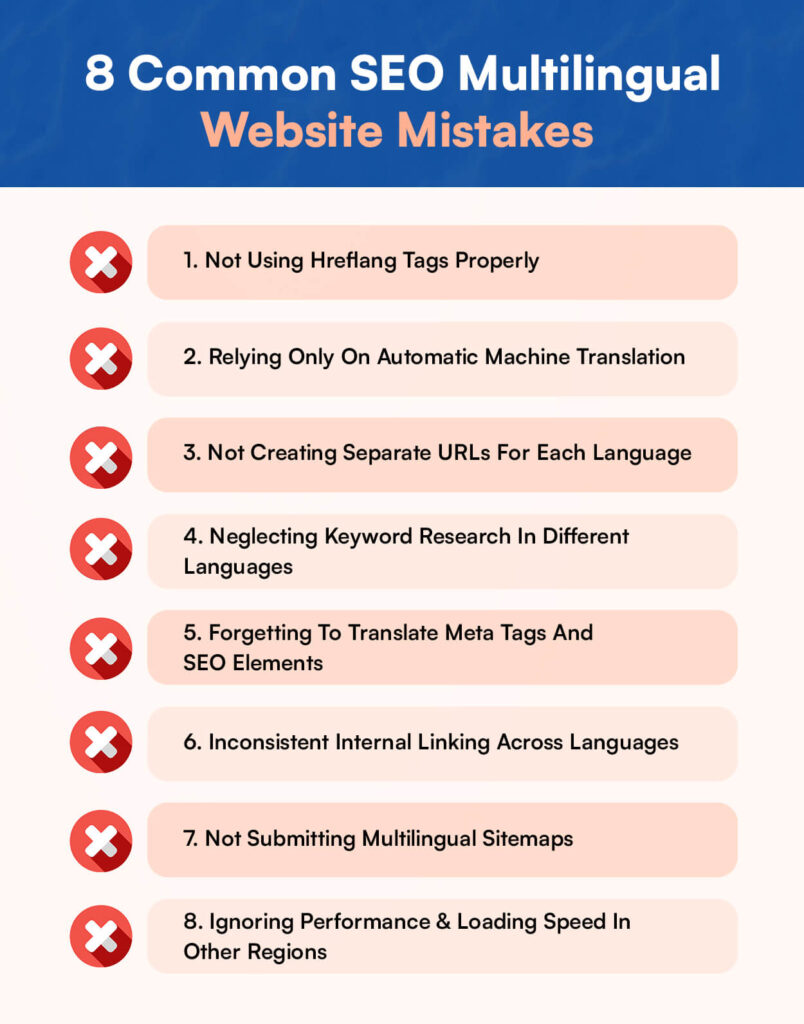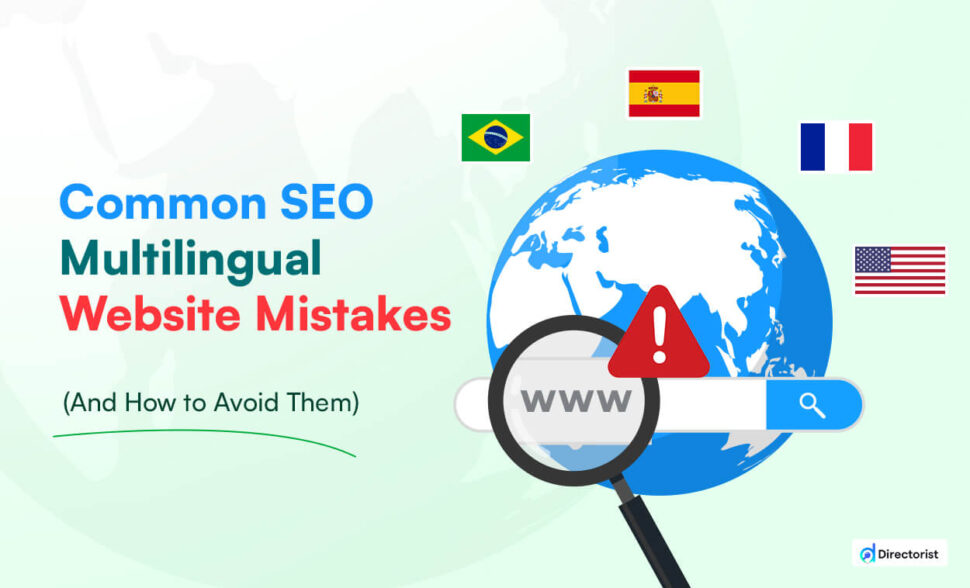Contents
- Why SEO for Multilingual Websites Is Critical
- 8 Common SEO Multilingual Website Mistakes (Bonus: Pro Tips To Avoid Them)
- 1. Not Using Hreflang Tags Properly
- 2. Relying Only On Automatic Machine Translation
- 3. Not Creating Separate URLs For Each Language
- 4. Neglecting Keyword Research In Different Languages
- 5. Forgetting To Translate Meta Tags And SEO Elements
- 6. Inconsistent Internal Linking Across Languages
- 7. Not Submitting Multilingual Sitemaps
- 8. Ignoring Performance & Loading Speed In Other Regions
- Conclusion & Final Thoughts
- FAQ
- 1. What is a SEO multilingual website?
- 2. Can I just use Google Translate to make my site multilingual?
- 3. Why is structure important in a multilingual website?
- 4. What is the function of hreflang tags in multilingual SEO?
- 5. Is it possible to create an SEO-friendly multilingual business directory site?
- 6. How do I track SEO performance across different languages?
8 Common SEO Multilingual Website Mistakes (And How to Avoid Them)
You’ve invested in a beautifully designed website, optimized your on-page SEO, and are starting to see some traction. But then you decide to go multilingual to tap into international markets—and suddenly, things get complicated. Your organic traffic drops in certain regions. Search engines don’t seem to recognize your translated pages. And worst of all? Users in different languages can’t even find your site through search.
This isn’t just frustrating—it’s a major missed opportunity. Without the right multilingual SEO setup, you’re not just leaving traffic on the table; you’re actively losing visibility in search engines, confusing your international visitors, and possibly getting penalized by Google for duplicate or poorly translated content. What’s meant to expand your reach might be holding you back.
The good news is: these issues are avoidable. In this guide, we’ll walk you through the most common SEO multilingual website mistakes—and more importantly, how to fix and prevent them. Whether you’re a business owner, developer, marketer, freelancer, or run a multilingual directory site, this article will give you the practical insights you need to ensure your global website is both user-friendly and search engine-friendly.
Let’s dive in and make sure your multi language website SEO strategy is bulletproof from the start.
Why SEO for Multilingual Websites Is Critical
Expanding your website into multiple languages isn’t just about translating words. It’s about building trust and visibility with global audiences. That’s where SEO for multi language websites plays a game-changing role.
1. Language-Specific Search Visibility
People do not search alike in all languages. What ranks in English might be completely invisible in Spanish, French, or German. Without proper SEO multilingual website, your translated content won’t appear in search results for users in other regions. This means you miss out on highly targeted organic traffic.
2. Improved User Experience By Location
Visitors are more likely to engage and convert when your content matches their language and cultural context. SEO-optimized multilingual websites ensure users are automatically directed to the correct version of your site. It helps to reduce bounce rates and increase engagement.
3. Business Expansion & Trust
Search engines like Google love relevance. Having fully localized, SEO-optimized pages builds credibility with international users and tells Google your site is serious about serving that market. This helps build brand trust, which is crucial for expanding your digital footprint.
4. Higher Conversions From Global Audiences
Localization goes hand-in-hand with higher conversions. A multilingual SEO strategy ensures not just visibility, but also better alignment with buyer intent in different regions. Whether you run a blog, directory website, or eCommerce store, ranking well globally means more leads, signups, and sales.
5. Avoiding Duplicate Content Penalties
Duplicate content is one of the biggest threats to multilingual websites. Always keep strict to publish authentic content. Without SEO best practices (like proper hreflang tags), Google might penalize your site, reducing visibility across all languages.
In short, if you’re serious about international growth, SEO for your multilingual website isn’t optional—it’s essential. Let’s now look at the mistakes many site owners make so you can avoid them altogether.
8 Common SEO Multilingual Website Mistakes (Bonus: Pro Tips To Avoid Them)

Translating your website into multiple languages is a smart move—but if it’s not done properly, it can backfire hard on your SEO. Many business owners, marketers, and even developers overlook critical steps that cause their international traffic to suffer.
Here are some of the most common SEO multilingual website mistakes—and how to avoid them:
1. Not Using Hreflang Tags Properly
The mistake: Many multilingual websites either skip hreflang tags altogether or implement them incorrectly. This confuses search engines about which version of your content to show users in different regions.
The fix: Always add proper hreflang annotations to tell Google which language and region each page targets. For example:
<link rel=”alternate” hreflang=”es” href=”https://example.com/es/” />
This helps users access the right version of your site depending on their location and language.
2. Relying Only On Automatic Machine Translation
The mistake: Auto-translating your entire site using machine tools without human review can result in awkward, inaccurate, or culturally insensitive content.
The fix: Use human translators for key pages like homepage, product pages, or service descriptions. A plugin like WPML, TranslatePress, or Polylang with manual override options can help. Accuracy boosts SEO rankings and user trust.
3. Not Creating Separate URLs For Each Language
The mistake: Serving all language versions from the same URL using dynamic content (JavaScript or cookies) prevents search engines from indexing the translations correctly.
The fix: Use distinct, indexable URLs for each language version. For example:
example.com/en/ for English
example.com/fr/ for French
This structure helps Google index each version individually for region-specific searches.
4. Neglecting Keyword Research In Different Languages
The mistake: Translating English keywords directly to other languages doesn’t account for local search behavior.
The fix: Do language-specific keyword research for every version of your site. What works in the US might not work in Spain or Japan. Tools like Google Keyword Planner, Ahrefs, or SEMrush allow you to drill into region-specific terms.
5. Forgetting To Translate Meta Tags And SEO Elements
The mistake: Leaving meta titles, descriptions, alt text, and structured data in the original language reduces your site’s visibility in local search engines.
The fix: Translate all on-page SEO elements, not just the visible content. This includes:
- Title tags
- Meta descriptions
- Image alt tags
- Open Graph tags
- Schema markup
These are ranking signals and should align with local language and intent.
6. Inconsistent Internal Linking Across Languages
The mistake: Linking from an English page to a French page (or vice versa) without offering the user the correct language context can break navigation and confuse users.
The fix: Make sure internal links stay within the same language version. Use localized navigation menus, footers, and call-to-actions to keep users in their preferred experience.
7. Not Submitting Multilingual Sitemaps
The mistake: Failing to submit different language versions of your sitemap to search engines means Google might not discover or index them.
The fix: Make multilingual sitemaps and submit them using Google Search Console and Bing Webmaster Tools. Plugins like TranslatePress SEO Pack or WPML offer built-in support for multilingual sitemaps.
8. Ignoring Performance & Loading Speed In Other Regions
The mistake: Serving translated content from a single server without CDN support can slow down your site for international visitors—hurting both UX and SEO.
The fix: Use a reliable CDN and ensure your multilingual pages load quickly from any location. Speed is a must-have ranking factor and improves conversions.
Conclusion & Final Thoughts
Creating a multilingual website is a smart move—but only if it’s built with SEO in mind.
As we’ve seen, even the most well-intentioned websites can fall into common traps like missing hreflang tags, relying too heavily on automatic translation, or failing to structure URLs properly. These SEO multilingual website mistakes don’t just hurt your visibility—they block your site from reaching the very audience you’re trying to serve.
The good news? These issues are manageable with the right strategy and tools. By planning your site structure, translating all essential elements, optimizing for local search engines, and maintaining consistency across languages, you set your multilingual website up for long-term success in global search results.
And if you’re running a business directory site, multilingual SEO isn’t optional—it’s essential. A localized experience increases trust, drives more qualified traffic, and opens the door to new revenue opportunities.
Now that you’re equipped with what not to do and how to get it right, it’s time to act.
So, let’s recap the key outlines about common SEO multilingual website mistakes
- Translation alone isn’t enough. You need a proper multi language site SEO structure and optimization to rank in global markets.
- Avoid machine-only translations. Automated translations may be fast, but make sure to meet both user experience and search engine trust.
- Keep heed to the website Structure. Use subdirectories, subdomains, or ccTLDs wisely to make your site scalable and understandable for search engines.
- Focus on every element to align across languages to avoid confusion and SEO dilution.
- Choose the right tools. Plugins like WPML, Polylang, TranslatePress—or SEO-friendly directory builders like Directorist—can simplify and automate best practices.
If you’re planning to build an SEO-friendly, multilingual-ready solution for a directory business, you can try Directorist. Don’t worry about code or extra budget. You can create a complete directory website, although you have no coding skills and without any cost.
And don’t forget to share this article with your team or network—it could save someone else from making the same mistakes. Got questions or insights to share? Join our community.
Don’t forget check out these resources: 👇
- How to Create WordPress Multi Language Directory Website (No Coding Needed)
- How To Use WPML With Directorist (The Complete Guide)
- WPML vs Polylang vs TranslatePress: Which Website Translation Plugin Should You Choose?
FAQ
1. What is a SEO multilingual website?
A SEO multilingual website is a website that’s available in multiple languages and optimized to rank well in search engines for each language. It combines accurate translations with technical SEO elements like hreflang tags, localized URLs, and language-specific metadata to reach international audiences effectively.
2. Can I just use Google Translate to make my site multilingual?
While Google Translate can help with quick translations, relying solely on it isn’t ideal for SEO or user experience. It doesn’t create unique, indexable content or handle essential SEO elements like metadata or proper URL structures—both of which are crucial for multilingual SEO.
3. Why is structure important in a multilingual website?
Search engines need to understand the relationship between your language versions. A proper structure—whether via subdirectories (example.com/fr), subdomains (fr.example.com), or ccTLDs (example.fr)—helps crawlers index the right version for the right region and prevents content duplication.
hreflang tags tell search engines which version of a page to show to users based on their language or location. Without them, your pages might compete with each other in search rankings, hurting your visibility and click-through rates.
5. Is it possible to create an SEO-friendly multilingual business directory site?
Yes! Using a directory plugin like Directorist, you can build a multilingual directory that’s fully optimized for SEO. It supports translation tools, lets you localize categories and taxonomies, and helps structure your content for global audiences.
6. How do I track SEO performance across different languages?
You can use tools like Google Search Console, Google Analytics, or Ahrefs to monitor how each language version of your site is performing. Look at metrics like impressions, clicks, CTR, and keyword positions by country and language segment.




Leave a Reply
You must be logged in to post a comment.